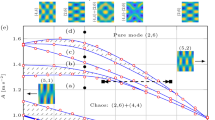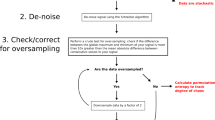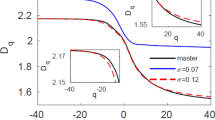Abstract
During the past five years general rules have been developed for the application of chaos theory to biology and medicine, which enable investigators to avoid the pitfalls that invalidated and trivialized many earlier results. The importance of biological chaos is that the variables governing the spatial and temporal geometries of the system may be few in number, fractional in dimension, and thus enable low-energy control with complex deterministic consequences. The complexity of control inherent in chaotic systems may be important in the dynamics of gene expression and translation. Extending these ideas may lead to completely novel ways to modulate protein production by introducing simple pulses at critical times or places.
This is a preview of subscription content, access via your institution
Access options
Subscribe to this journal
Receive 12 print issues and online access
$209.00 per year
only $17.42 per issue
Buy this article
- Purchase on Springer Link
- Instant access to full article PDF
Prices may be subject to local taxes which are calculated during checkout
Similar content being viewed by others
References
Packard, N.H., Crutchfield, J.P., Farmer, J.D. and Shaw, R.S. 1980. Geometry from a time series. Physical Review Letters 45: 712–716.
Takens, F. 1981. Detecting strange attractors in turbulance. Lecture Notes in Mathematics 898: 366–381.
Takens, F. 1985. On the numerical determination of the dimension of an attractor. Lecture Notes in Mathematics 1125: 99–106.
Grassberger, P. and Procaccia, I. 1983. Characterization of strange attractors. Physical Review Letters 50(5): 346–349.
Mandelbrot, B. 1982. Fractal Geometry of Nature. WH Freeman, San Francisco.
Mühlnickel, W., Rendtorff, N., Kowalik, Z.J., Rockstroh, B., Miltner, W. and Elbert, T. 1994. Testing the determinism of EEG and MEG. Integrative Physiological and Behavioral Science 29: In press.
Kaplan, D.T. and Glass, L. 1992. Direct test for determinism in a time series. Physical Review Letters 68: 427–430.
Kowalik, Z.J. and Elbert, T. 1994. Changes of chaoticness in spontaneous EEG/MEG. Integrative Physiological and Behavioral Science 29: In press.
Rapp, P.E. 1994. A guide to dynamical analysis. Integrative Physiological and Behavioral Science 29: In press.
Theiler, J.T. 1986. Spurious dimension from correlation algorithms applied to limited time-series data. Physical Reviews 34: 2427–2432.
Theiler, J., Eubank, S., Longtin, A., Galdrikian, B. and Farmer, J.D. 1992. Testing for nonlinearity in time series: the method of surrogate data. Physica 58: 77–94.
Schiff, S.J., Sauer, T. and Chang, T. 1994. Discriminating deterministic versus stochastic dynamics in neuronal activity. Integrative Physiological and Behavioral Science 29: In press.
Skinner, J.E., Molnar, M. and Tomberg, C. 1994. The point correlation dimension: Performance with non-stationary surrogate data and noise. Integrative Physiological and Behavioral Science 29: In press.
Freeman, W.J. 1975. Mass Action in the Nervous System. Academic Press, NY.
Freeman, W.J. 1987. Simulation of chaotic EEG patterns with a dynamic model of the olfactory system. Biol Cybernetics 56: 139–150.
Mayer-Kress, G. 1994. Localized measures for non-stationary time-series of physiological data. Integrative Physiological and Behavioral Science 29: In press.
Skinner, J.E., Pratt, C.M. and Vybiral, T.A. 1993. A reduction in the correlation dimension of heart beat intervals proceeds imminent ventricular fibrillation in human subjects. American Heart Journal 125: 731–743.
Vybiral, T. and Skinner, J.E. 1993. The point correlation dimension of R-R intervals predicts sudden cardiac death among high risk patients, p. 257–260. In: IEEE Computer Society Press Proceedings: Computers in Cardiology. Los Alametos, CA.
Kleiger, R.E., Miller, J.P., Bigger, J.T., Moss, A.J. and the Multicenter Post-Infarction Research Group. 1988. Decreased heart rate variability and its association with increased mortality after acute myocardial infarction. American Heart Journal 59: 256–262.
Lombardi, F., Sandorne, G., Pernpruner, S., Sala, R., Garimoldi, M., Cerutti, S., Baselli, G., Pagani, M. and Malliani, A. 1987. Heart rate variability as an index of sympathovagal interaction after acute myocardial infarction. American Journal of Cardiology 60: 1239–1245.
Garfinkel, A., Spano, M.L., Ditto, W.L. and Weiss, J.N. 1992. Controlling cardiac chaos. Science 257: 1230–1235.
Bergold, P.J., Sweatt, J.D., Winicov, I., Weiss, K.R., Kandel, E.R. and Schwartz, J.H. 1990. Protein synthesis during acquisition of long-term facilitation is needed for the persistent loss of regulatory subunits of the Aplysia cAMP-dependent protein kinase. Proc. Natl. Acad. Sci. USA 87: 3788–3791.
Madison, D.V. 1993. Pass the nitric oxide. Proc. Natl. Acad. Sci. USA 90: 4329–4331.
Mitra, M. and Skinner, J.E. 1992. Low-dimensional chaos maps learning in a model neuropil (olfactory bulb). Integrative Physiological and Behavioral Science 27: 305–322.
Skarda, C.A. and Freeman, W.J. 1987. How brains make chaos in order to make sense of the world. Behavioral and Brain Sciences 10: 161–195.
Barnsley, M.F., Massopust, P., Strickland, H. and Sloan, A.D. 1987. Fractal modeling of biological structures. Annals of New York Acad. Sci. 504: 179–194.
Barnsley, M.F. and Sloan, A.D. 1987. Chaotic compression: a new twist on fractal theory speeds complex image transmission to video rates. Computer Graphics World Nov: 107–108.
Skinner, J.E., Carpeggiani, C., Landisman, C.E. and Fulton, K.W. 1991. The correlation-dimension of heart beat intervals is reduced in conscious pigs by myocardial ischemia. Circulation Research 68: 966–976.
Skinner, J.E. 1994. Neurocardiology: How stress produces fatal cardiac arrhythmias. In: Arrhythmia: A Clinical Approach. P.J. Podrid and P.R. Kowey (Eds.). Williams & Wilkins, Baltimore, MD. In press.
Skinner, J.E., Lie, J.T. and Entman, M.L. 1975. Modification of ventricular fibrillation latency following coronary artery occlusion in the conscious pig: The effects of psychological stress and beta-adrenergic blockade. Circulation 51: 656–667.
Peng, C.K., Buldyrev, S.V., Hausdorff, J.M., Havlin, S., Mietus, J.E., Simons, M., Stanley, H.E. and Goldberger, A.L. 1994. Instability as an indispensable characteristic of a healthy biological system. Integrative Physiological and Behavioral Science 29: In press.
Goldberger, A.L., Rigney, D.R. and West, B.J. 1990. Chaos and fractals in human physiology. Sci. Amer. 262: 42–49.
Rossler, O.E. and Rossler, R. 1994. Chaos in physiology. Integrative Physiological and Behavioral Science 29: In press.
Elbert, T., Ray, W.J., Kowalik, Z.J., Skinner, J.E., Graf, K.E. and Birbaumer, N. 1994. Chaos and physiology. Physiological Reviews 74: 1–47.
Wolf, S. 1994. Introducing chaos. Integrative Physiological and Behavioral Science 29: In press.
Winfree, A.T. 1987. When Time Breaks Down. Princeton University Press, Princeton, NJ.
Peng, C.K., Buldyrev, S.V., Goldberger, A.L., Havlin, S., Sciortino, F., Simons, M. and Stanley, H.E. 1992. Long-range correlations in nucleotide sequences. Nature 356: 168–170.
Author information
Authors and Affiliations
Corresponding author
Rights and permissions
About this article
Cite this article
Skinner, J. Low-dimensional Chaos in Biological Systems. Nat Biotechnol 12, 596–600 (1994). https://doi.org/10.1038/nbt0694-596
Issue Date:
DOI: https://doi.org/10.1038/nbt0694-596
This article is cited by
-
Chaos, antimonotonicity and coexisting attractors in Van der Pol oscillator based electronic circuit
Analog Integrated Circuits and Signal Processing (2022)
-
Hyperchaotic behaviors, optimal control, and synchronization of a nonautonomous cardiac conduction system
Advances in Difference Equations (2021)
-
Identification of Stochastically Perturbed Autonomous Systems from Temporal Sequences of Probability Density Functions
Journal of Nonlinear Science (2018)
-
Sensitivity of Chaos Measures in Detecting Stress in the Focusing Control Mechanism of the Short-Sighted Eye
Bulletin of Mathematical Biology (2017)
-
Mathematical analysis of the homing flights of pigeons based on GPS tracks
Journal of Comparative Physiology A (2016)



